Life Sciences Workbook: RPL Portfolio, Mental Health Nursing
VerifiedAdded on 2021/07/09
|46
|5776
|317
Homework Assignment
AI Summary
This life sciences workbook is designed for nursing students enrolled in a Pg Dip/MSc program, specifically focusing on mental health nursing. The workbook covers a wide range of topics related to human anatomy and physiology, including body compartments, cells, homeostasis, the integumentary, musculoskeletal, cardiovascular, respiratory, renal, gastrointestinal, nervous, endocrine, and reproductive systems. It also addresses wound healing and temperature regulation. The workbook serves as a learning resource to enhance the students' understanding of the body's structures and systems, providing a foundation for their nursing studies. The content includes definitions, identification of organ locations, descriptions of cell structures and functions, explanations of physiological processes like osmosis and diffusion, and outlines of key concepts like homeostasis, skin layers, and wound healing stages. The workbook aims to equip students with the necessary knowledge to succeed in their nursing program, and is to be submitted with their RPL portfolio as evidence of acquired knowledge. The workbook also includes learning resources such as a recommended reading list.
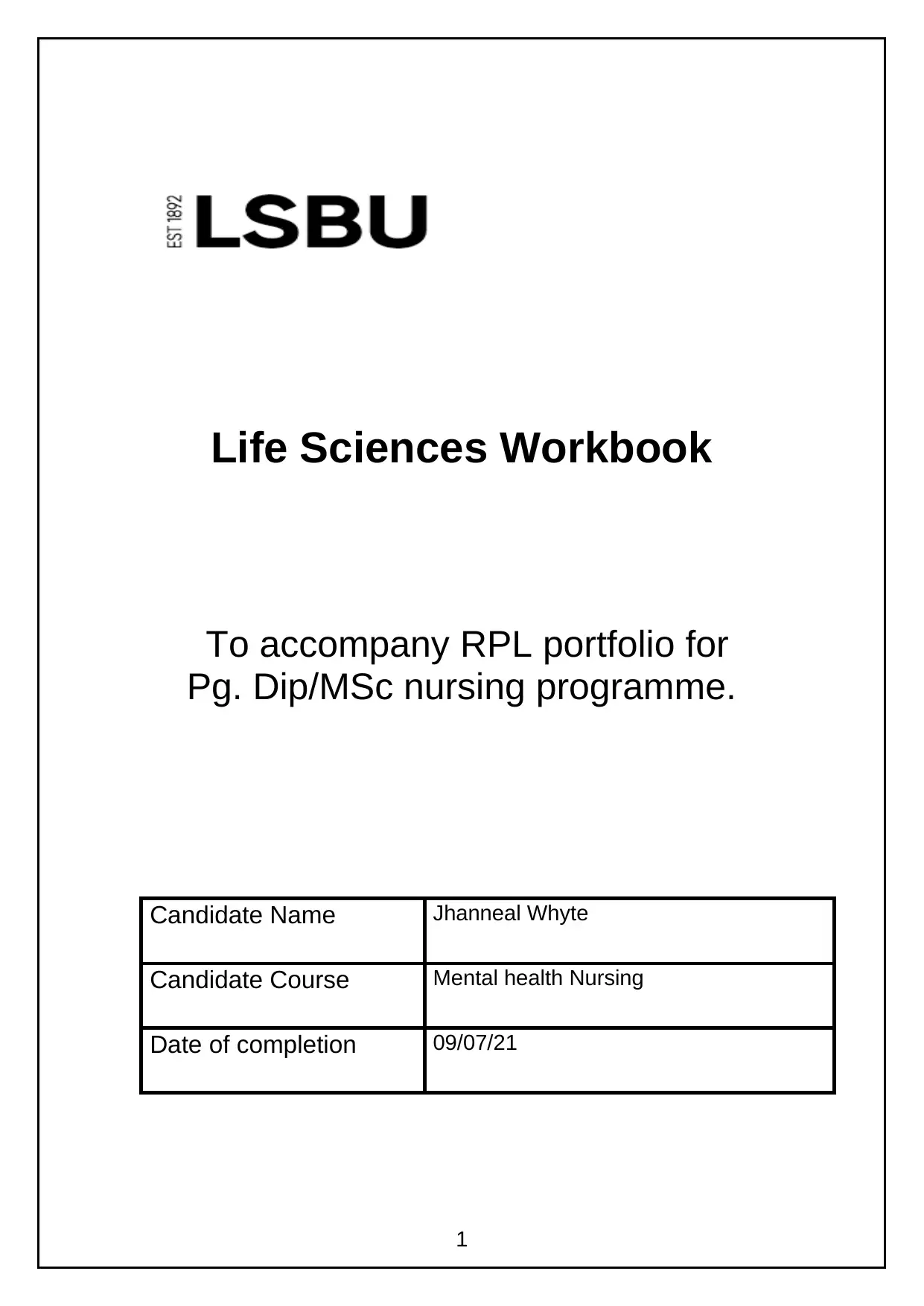
Life Sciences Workbook
To accompany RPL portfolio for
Pg. Dip/MSc nursing programme.
Candidate Name Jhanneal Whyte
Candidate Course Mental health Nursing
Date of completion 09/07/21
1
To accompany RPL portfolio for
Pg. Dip/MSc nursing programme.
Candidate Name Jhanneal Whyte
Candidate Course Mental health Nursing
Date of completion 09/07/21
1
Paraphrase This Document
Need a fresh take? Get an instant paraphrase of this document with our AI Paraphraser
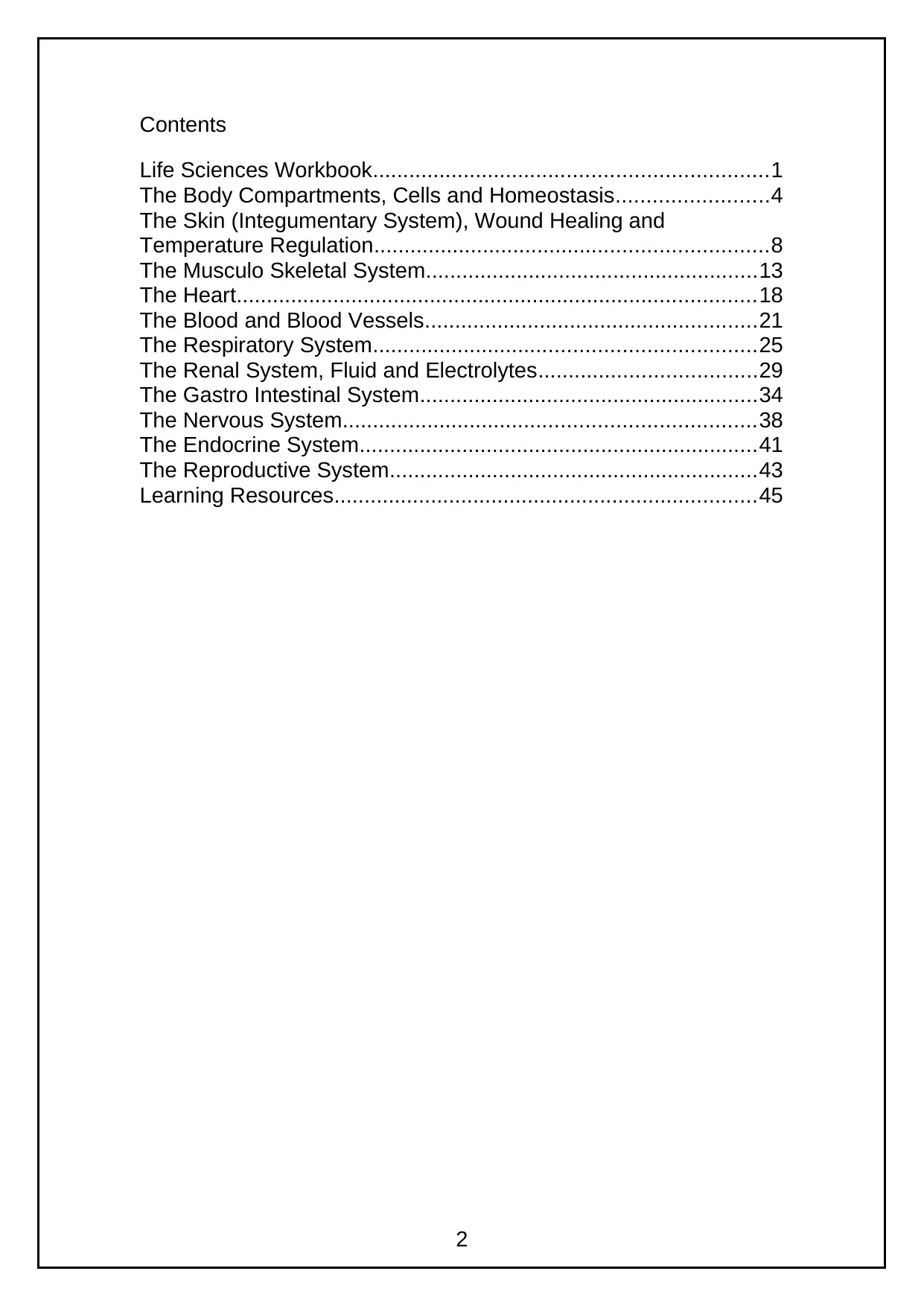
Contents
Life Sciences Workbook.................................................................1
The Body Compartments, Cells and Homeostasis.........................4
The Skin (Integumentary System), Wound Healing and
Temperature Regulation.................................................................8
The Musculo Skeletal System.......................................................13
The Heart......................................................................................18
The Blood and Blood Vessels.......................................................21
The Respiratory System...............................................................25
The Renal System, Fluid and Electrolytes....................................29
The Gastro Intestinal System........................................................34
The Nervous System....................................................................38
The Endocrine System..................................................................41
The Reproductive System.............................................................43
Learning Resources......................................................................45
2
Life Sciences Workbook.................................................................1
The Body Compartments, Cells and Homeostasis.........................4
The Skin (Integumentary System), Wound Healing and
Temperature Regulation.................................................................8
The Musculo Skeletal System.......................................................13
The Heart......................................................................................18
The Blood and Blood Vessels.......................................................21
The Respiratory System...............................................................25
The Renal System, Fluid and Electrolytes....................................29
The Gastro Intestinal System........................................................34
The Nervous System....................................................................38
The Endocrine System..................................................................41
The Reproductive System.............................................................43
Learning Resources......................................................................45
2
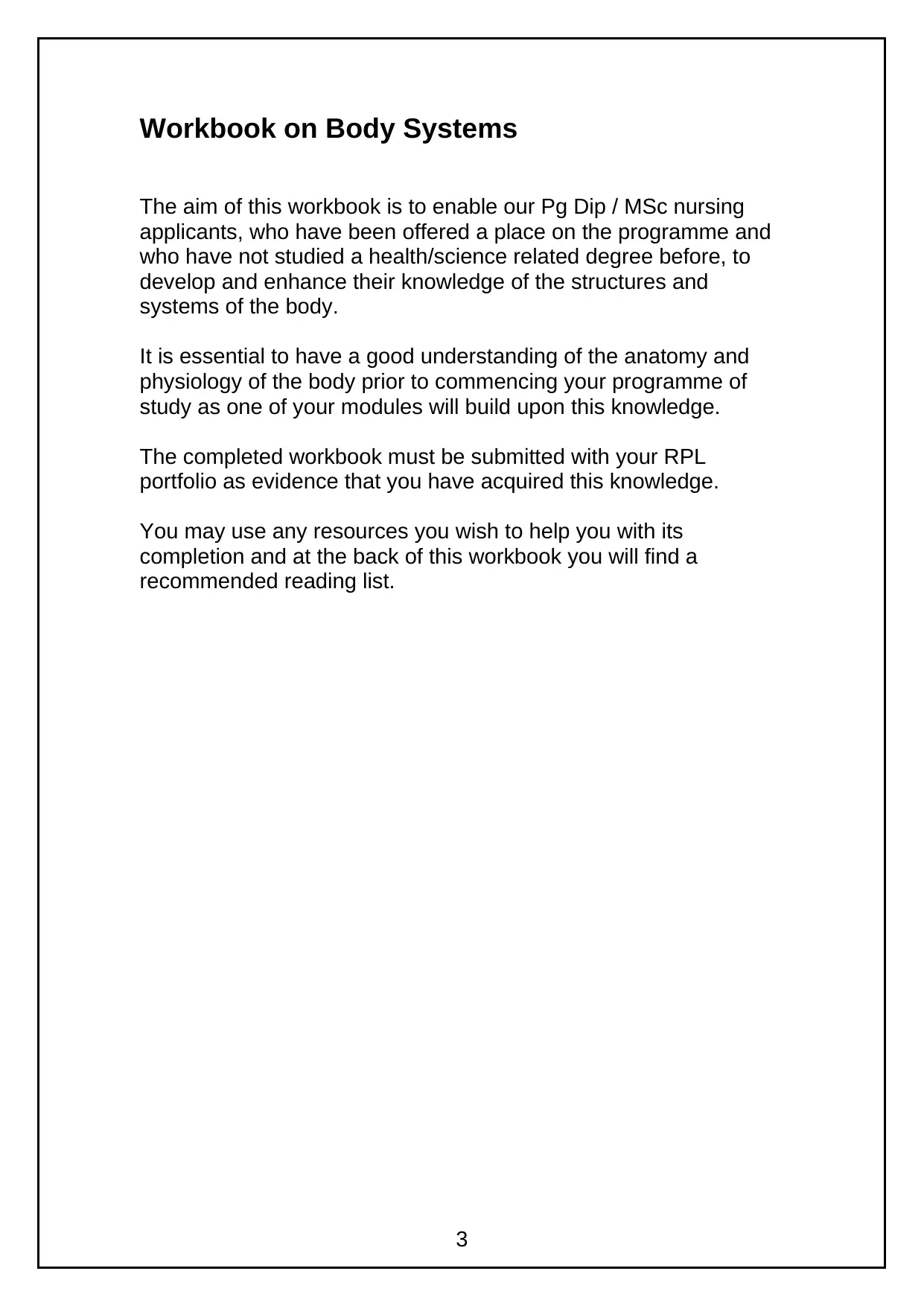
Workbook on Body Systems
The aim of this workbook is to enable our Pg Dip / MSc nursing
applicants, who have been offered a place on the programme and
who have not studied a health/science related degree before, to
develop and enhance their knowledge of the structures and
systems of the body.
It is essential to have a good understanding of the anatomy and
physiology of the body prior to commencing your programme of
study as one of your modules will build upon this knowledge.
The completed workbook must be submitted with your RPL
portfolio as evidence that you have acquired this knowledge.
You may use any resources you wish to help you with its
completion and at the back of this workbook you will find a
recommended reading list.
3
The aim of this workbook is to enable our Pg Dip / MSc nursing
applicants, who have been offered a place on the programme and
who have not studied a health/science related degree before, to
develop and enhance their knowledge of the structures and
systems of the body.
It is essential to have a good understanding of the anatomy and
physiology of the body prior to commencing your programme of
study as one of your modules will build upon this knowledge.
The completed workbook must be submitted with your RPL
portfolio as evidence that you have acquired this knowledge.
You may use any resources you wish to help you with its
completion and at the back of this workbook you will find a
recommended reading list.
3
⊘ This is a preview!⊘
Do you want full access?
Subscribe today to unlock all pages.

Trusted by 1+ million students worldwide
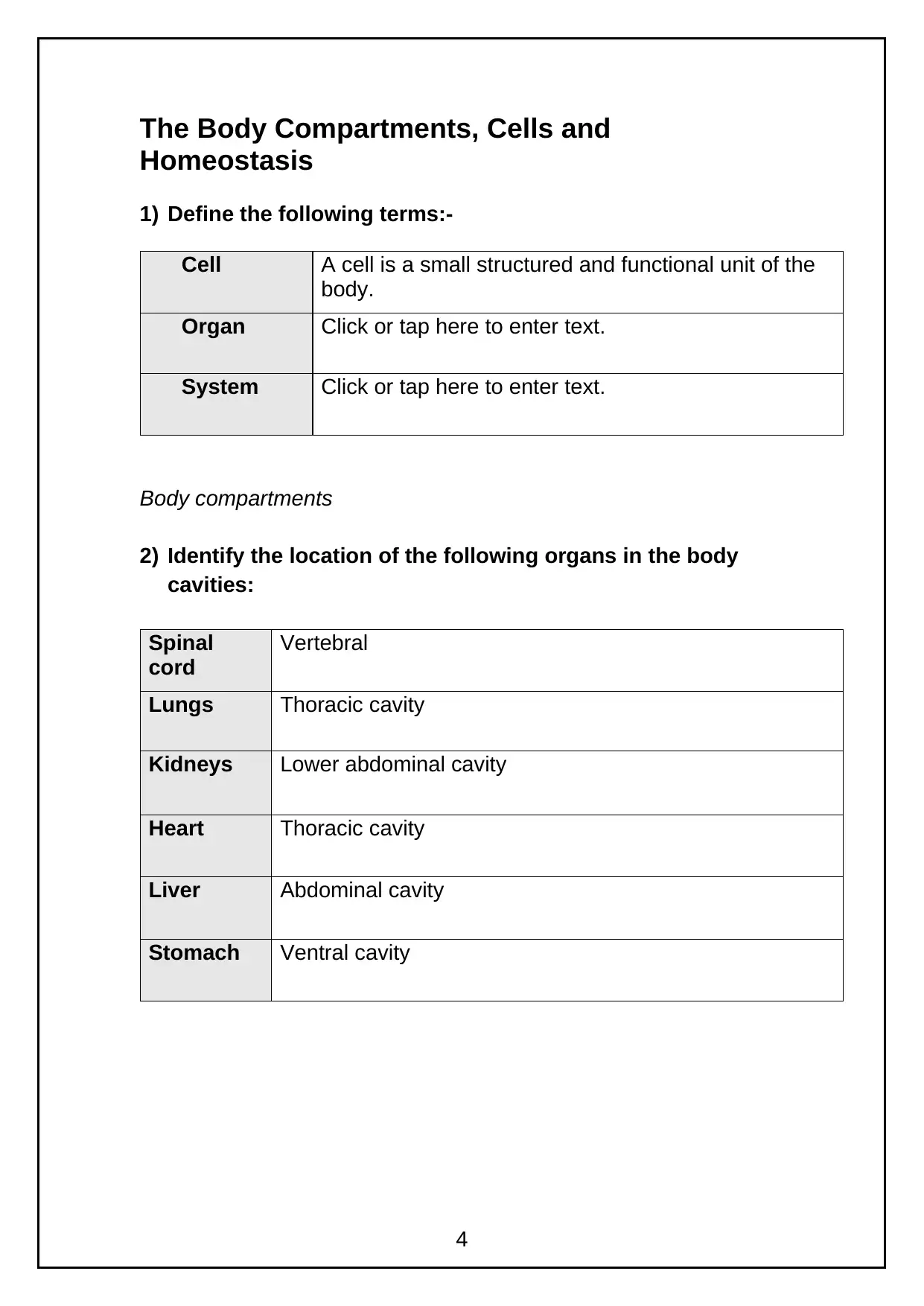
The Body Compartments, Cells and
Homeostasis
1) Define the following terms:-
Cell A cell is a small structured and functional unit of the
body.
Organ Click or tap here to enter text.
System Click or tap here to enter text.
Body compartments
2) Identify the location of the following organs in the body
cavities:
Spinal
cord
Vertebral
Lungs Thoracic cavity
Kidneys Lower abdominal cavity
Heart Thoracic cavity
Liver Abdominal cavity
Stomach Ventral cavity
4
Homeostasis
1) Define the following terms:-
Cell A cell is a small structured and functional unit of the
body.
Organ Click or tap here to enter text.
System Click or tap here to enter text.
Body compartments
2) Identify the location of the following organs in the body
cavities:
Spinal
cord
Vertebral
Lungs Thoracic cavity
Kidneys Lower abdominal cavity
Heart Thoracic cavity
Liver Abdominal cavity
Stomach Ventral cavity
4
Paraphrase This Document
Need a fresh take? Get an instant paraphrase of this document with our AI Paraphraser
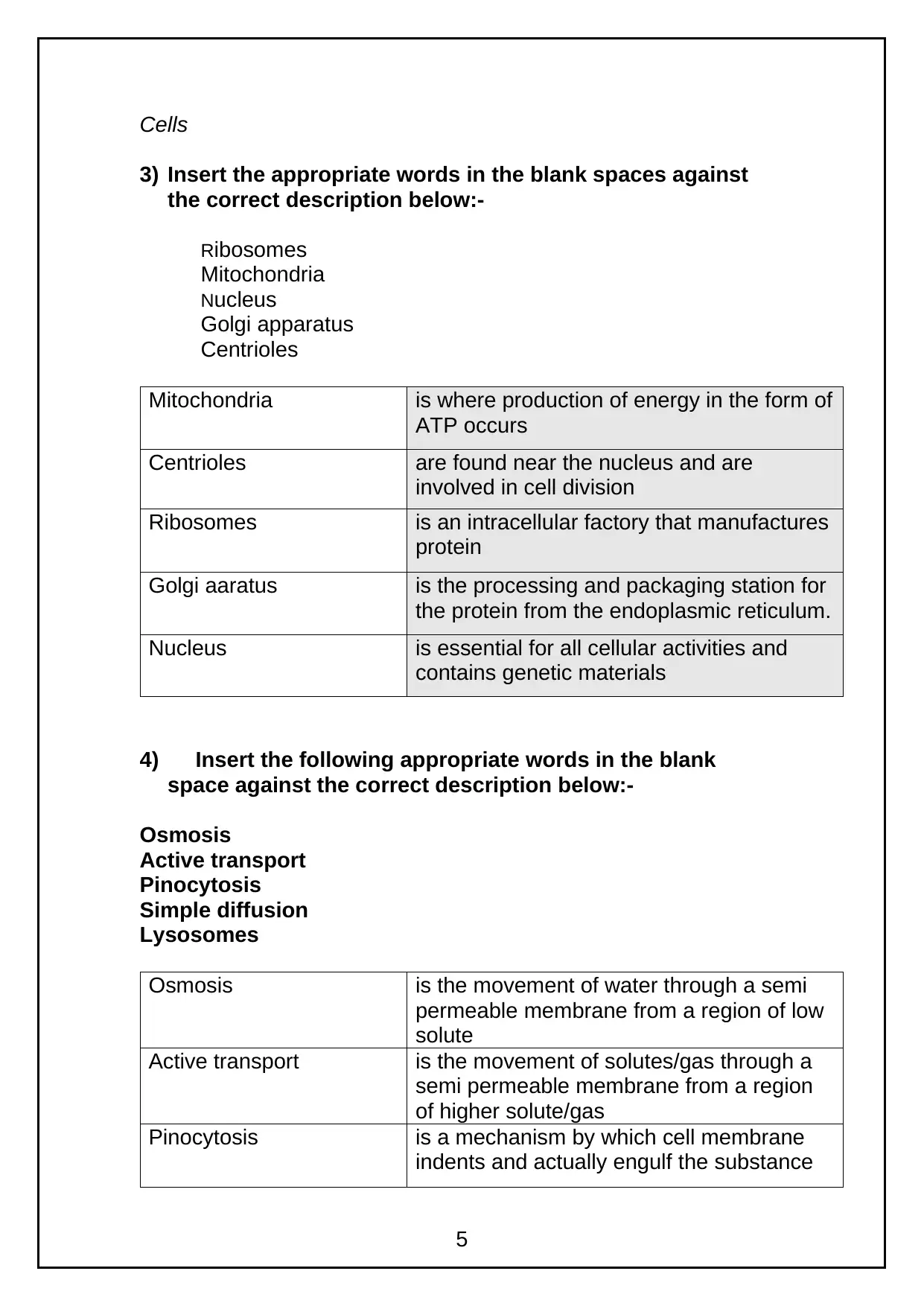
Cells
3) Insert the appropriate words in the blank spaces against
the correct description below:-
Ribosomes
Mitochondria
Nucleus
Golgi apparatus
Centrioles
Mitochondria is where production of energy in the form of
ATP occurs
Centrioles are found near the nucleus and are
involved in cell division
Ribosomes is an intracellular factory that manufactures
protein
Golgi aaratus is the processing and packaging station for
the protein from the endoplasmic reticulum.
Nucleus is essential for all cellular activities and
contains genetic materials
4) Insert the following appropriate words in the blank
space against the correct description below:-
Osmosis
Active transport
Pinocytosis
Simple diffusion
Lysosomes
Osmosis is the movement of water through a semi
permeable membrane from a region of low
solute
Active transport is the movement of solutes/gas through a
semi permeable membrane from a region
of higher solute/gas
Pinocytosis is a mechanism by which cell membrane
indents and actually engulf the substance
5
3) Insert the appropriate words in the blank spaces against
the correct description below:-
Ribosomes
Mitochondria
Nucleus
Golgi apparatus
Centrioles
Mitochondria is where production of energy in the form of
ATP occurs
Centrioles are found near the nucleus and are
involved in cell division
Ribosomes is an intracellular factory that manufactures
protein
Golgi aaratus is the processing and packaging station for
the protein from the endoplasmic reticulum.
Nucleus is essential for all cellular activities and
contains genetic materials
4) Insert the following appropriate words in the blank
space against the correct description below:-
Osmosis
Active transport
Pinocytosis
Simple diffusion
Lysosomes
Osmosis is the movement of water through a semi
permeable membrane from a region of low
solute
Active transport is the movement of solutes/gas through a
semi permeable membrane from a region
of higher solute/gas
Pinocytosis is a mechanism by which cell membrane
indents and actually engulf the substance
5
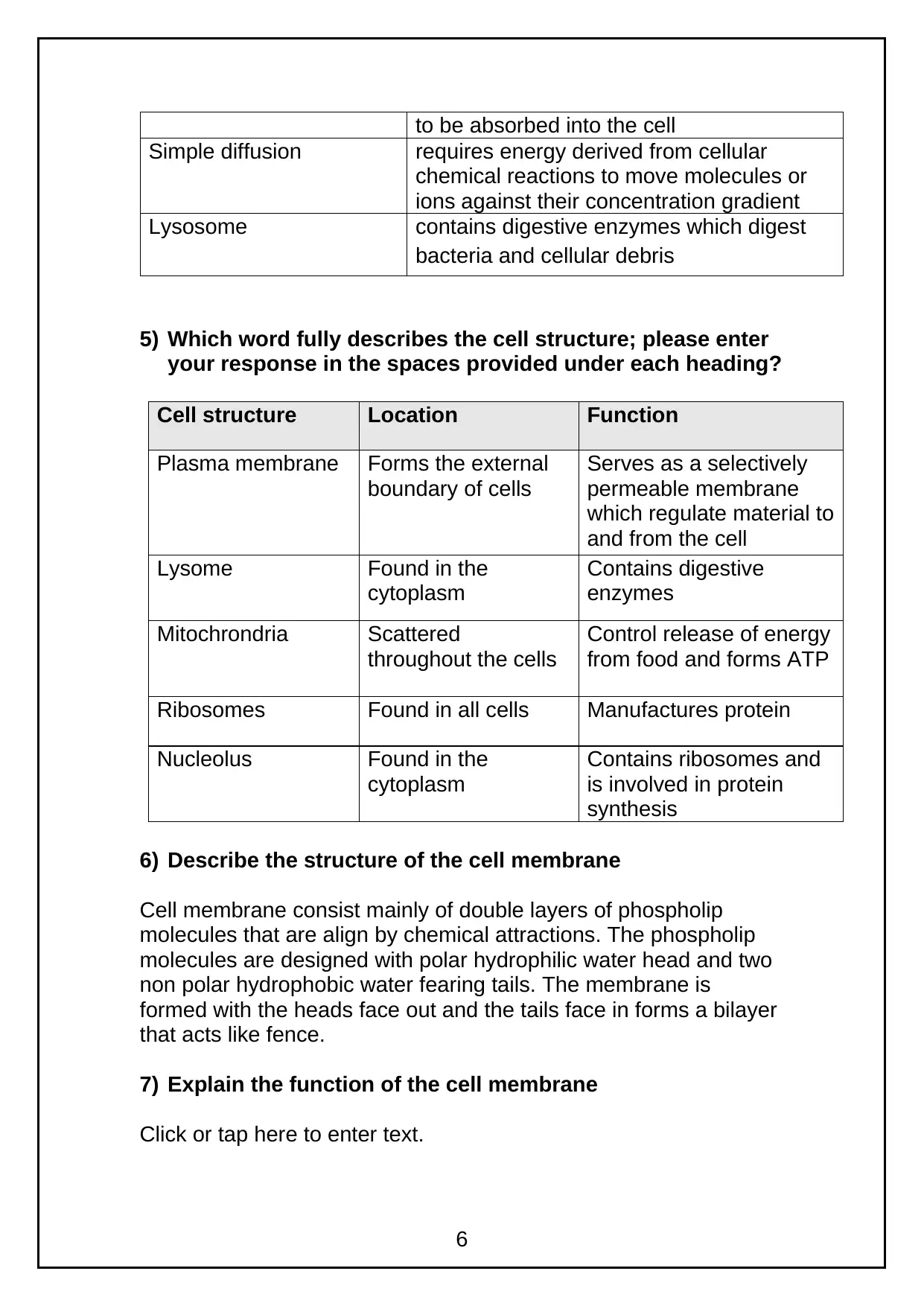
to be absorbed into the cell
Simple diffusion requires energy derived from cellular
chemical reactions to move molecules or
ions against their concentration gradient
Lysosome contains digestive enzymes which digest
bacteria and cellular debris
5) Which word fully describes the cell structure; please enter
your response in the spaces provided under each heading?
Cell structure Location Function
Plasma membrane Forms the external
boundary of cells
Serves as a selectively
permeable membrane
which regulate material to
and from the cell
Lysome Found in the
cytoplasm
Contains digestive
enzymes
Mitochrondria Scattered
throughout the cells
Control release of energy
from food and forms ATP
Ribosomes Found in all cells Manufactures protein
Nucleolus Found in the
cytoplasm
Contains ribosomes and
is involved in protein
synthesis
6) Describe the structure of the cell membrane
Cell membrane consist mainly of double layers of phospholip
molecules that are align by chemical attractions. The phospholip
molecules are designed with polar hydrophilic water head and two
non polar hydrophobic water fearing tails. The membrane is
formed with the heads face out and the tails face in forms a bilayer
that acts like fence.
7) Explain the function of the cell membrane
Click or tap here to enter text.
6
Simple diffusion requires energy derived from cellular
chemical reactions to move molecules or
ions against their concentration gradient
Lysosome contains digestive enzymes which digest
bacteria and cellular debris
5) Which word fully describes the cell structure; please enter
your response in the spaces provided under each heading?
Cell structure Location Function
Plasma membrane Forms the external
boundary of cells
Serves as a selectively
permeable membrane
which regulate material to
and from the cell
Lysome Found in the
cytoplasm
Contains digestive
enzymes
Mitochrondria Scattered
throughout the cells
Control release of energy
from food and forms ATP
Ribosomes Found in all cells Manufactures protein
Nucleolus Found in the
cytoplasm
Contains ribosomes and
is involved in protein
synthesis
6) Describe the structure of the cell membrane
Cell membrane consist mainly of double layers of phospholip
molecules that are align by chemical attractions. The phospholip
molecules are designed with polar hydrophilic water head and two
non polar hydrophobic water fearing tails. The membrane is
formed with the heads face out and the tails face in forms a bilayer
that acts like fence.
7) Explain the function of the cell membrane
Click or tap here to enter text.
6
⊘ This is a preview!⊘
Do you want full access?
Subscribe today to unlock all pages.

Trusted by 1+ million students worldwide
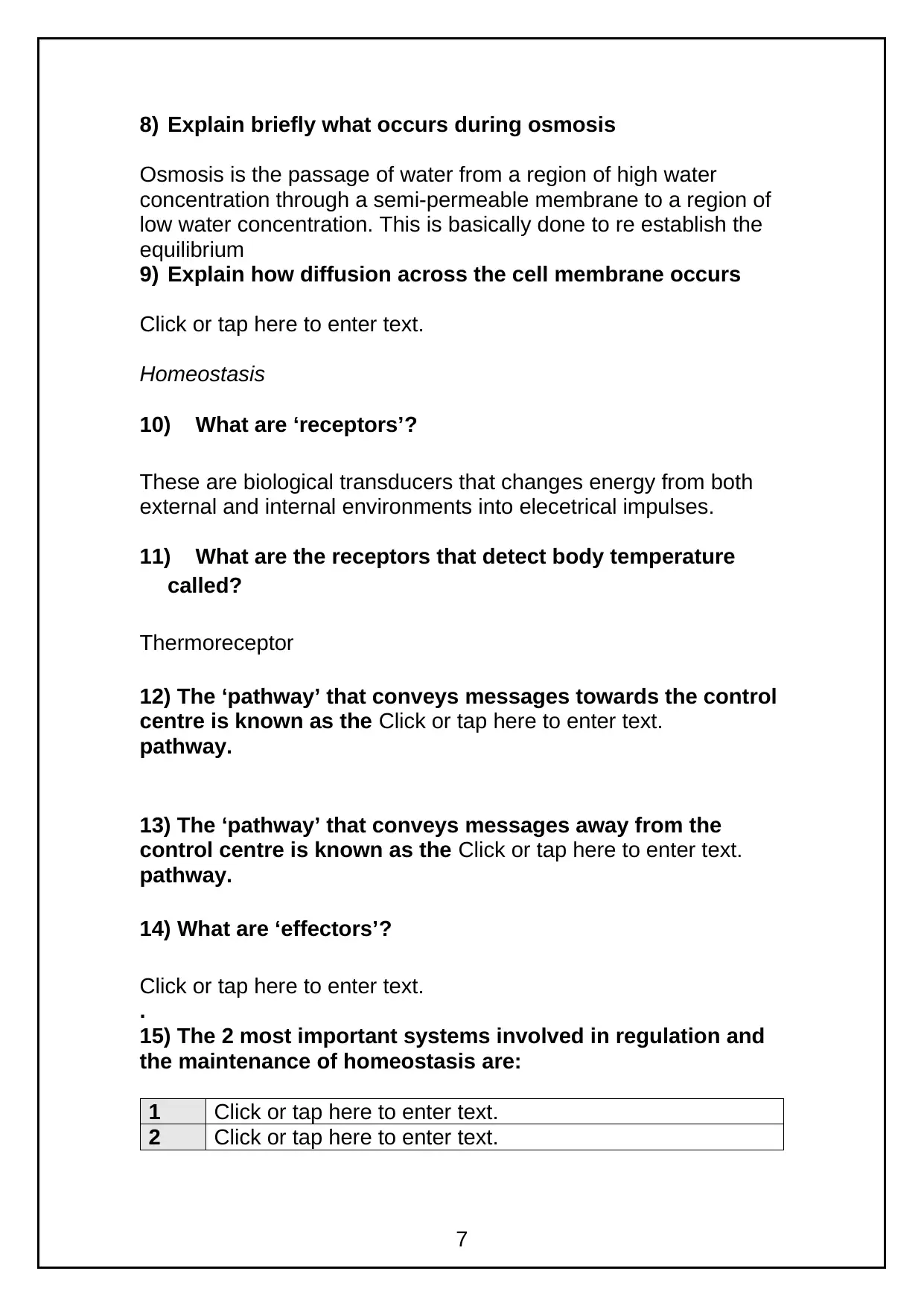
8) Explain briefly what occurs during osmosis
Osmosis is the passage of water from a region of high water
concentration through a semi-permeable membrane to a region of
low water concentration. This is basically done to re establish the
equilibrium
9) Explain how diffusion across the cell membrane occurs
Click or tap here to enter text.
Homeostasis
10) What are ‘receptors’?
These are biological transducers that changes energy from both
external and internal environments into elecetrical impulses.
11) What are the receptors that detect body temperature
called?
Thermoreceptor
12) The ‘pathway’ that conveys messages towards the control
centre is known as the Click or tap here to enter text.
pathway.
13) The ‘pathway’ that conveys messages away from the
control centre is known as the Click or tap here to enter text.
pathway.
14) What are ‘effectors’?
Click or tap here to enter text.
.
15) The 2 most important systems involved in regulation and
the maintenance of homeostasis are:
1 Click or tap here to enter text.
2 Click or tap here to enter text.
7
Osmosis is the passage of water from a region of high water
concentration through a semi-permeable membrane to a region of
low water concentration. This is basically done to re establish the
equilibrium
9) Explain how diffusion across the cell membrane occurs
Click or tap here to enter text.
Homeostasis
10) What are ‘receptors’?
These are biological transducers that changes energy from both
external and internal environments into elecetrical impulses.
11) What are the receptors that detect body temperature
called?
Thermoreceptor
12) The ‘pathway’ that conveys messages towards the control
centre is known as the Click or tap here to enter text.
pathway.
13) The ‘pathway’ that conveys messages away from the
control centre is known as the Click or tap here to enter text.
pathway.
14) What are ‘effectors’?
Click or tap here to enter text.
.
15) The 2 most important systems involved in regulation and
the maintenance of homeostasis are:
1 Click or tap here to enter text.
2 Click or tap here to enter text.
7
Paraphrase This Document
Need a fresh take? Get an instant paraphrase of this document with our AI Paraphraser

16) Explain how the body strives to maintain homeostasis.
Click or tap here to enter text.
8
Click or tap here to enter text.
8
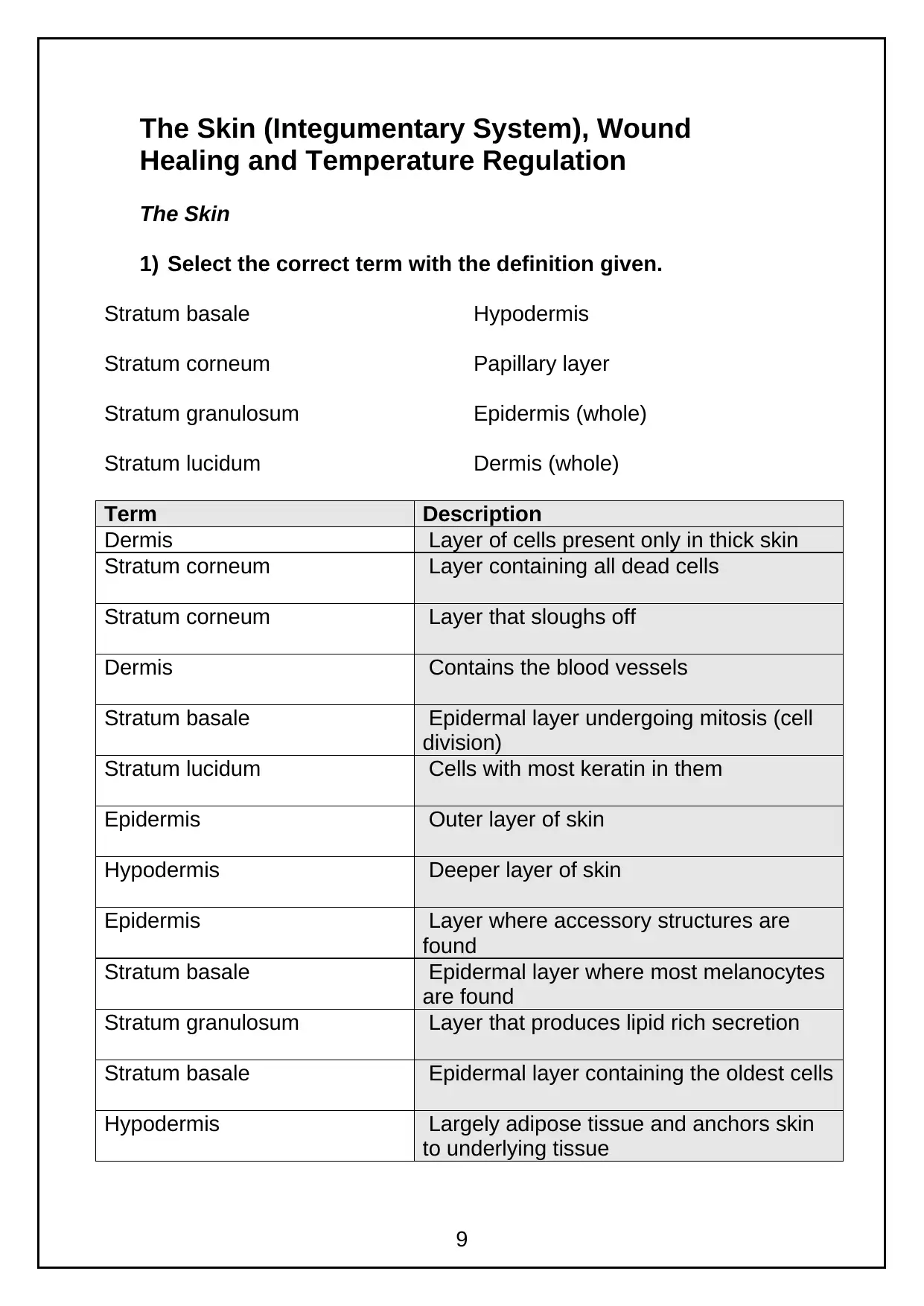
The Skin (Integumentary System), Wound
Healing and Temperature Regulation
The Skin
1) Select the correct term with the definition given.
Stratum basale Hypodermis
Stratum corneum Papillary layer
Stratum granulosum Epidermis (whole)
Stratum lucidum Dermis (whole)
Term Description
Dermis Layer of cells present only in thick skin
Stratum corneum Layer containing all dead cells
Stratum corneum Layer that sloughs off
Dermis Contains the blood vessels
Stratum basale Epidermal layer undergoing mitosis (cell
division)
Stratum lucidum Cells with most keratin in them
Epidermis Outer layer of skin
Hypodermis Deeper layer of skin
Epidermis Layer where accessory structures are
found
Stratum basale Epidermal layer where most melanocytes
are found
Stratum granulosum Layer that produces lipid rich secretion
Stratum basale Epidermal layer containing the oldest cells
Hypodermis Largely adipose tissue and anchors skin
to underlying tissue
9
Healing and Temperature Regulation
The Skin
1) Select the correct term with the definition given.
Stratum basale Hypodermis
Stratum corneum Papillary layer
Stratum granulosum Epidermis (whole)
Stratum lucidum Dermis (whole)
Term Description
Dermis Layer of cells present only in thick skin
Stratum corneum Layer containing all dead cells
Stratum corneum Layer that sloughs off
Dermis Contains the blood vessels
Stratum basale Epidermal layer undergoing mitosis (cell
division)
Stratum lucidum Cells with most keratin in them
Epidermis Outer layer of skin
Hypodermis Deeper layer of skin
Epidermis Layer where accessory structures are
found
Stratum basale Epidermal layer where most melanocytes
are found
Stratum granulosum Layer that produces lipid rich secretion
Stratum basale Epidermal layer containing the oldest cells
Hypodermis Largely adipose tissue and anchors skin
to underlying tissue
9
⊘ This is a preview!⊘
Do you want full access?
Subscribe today to unlock all pages.

Trusted by 1+ million students worldwide
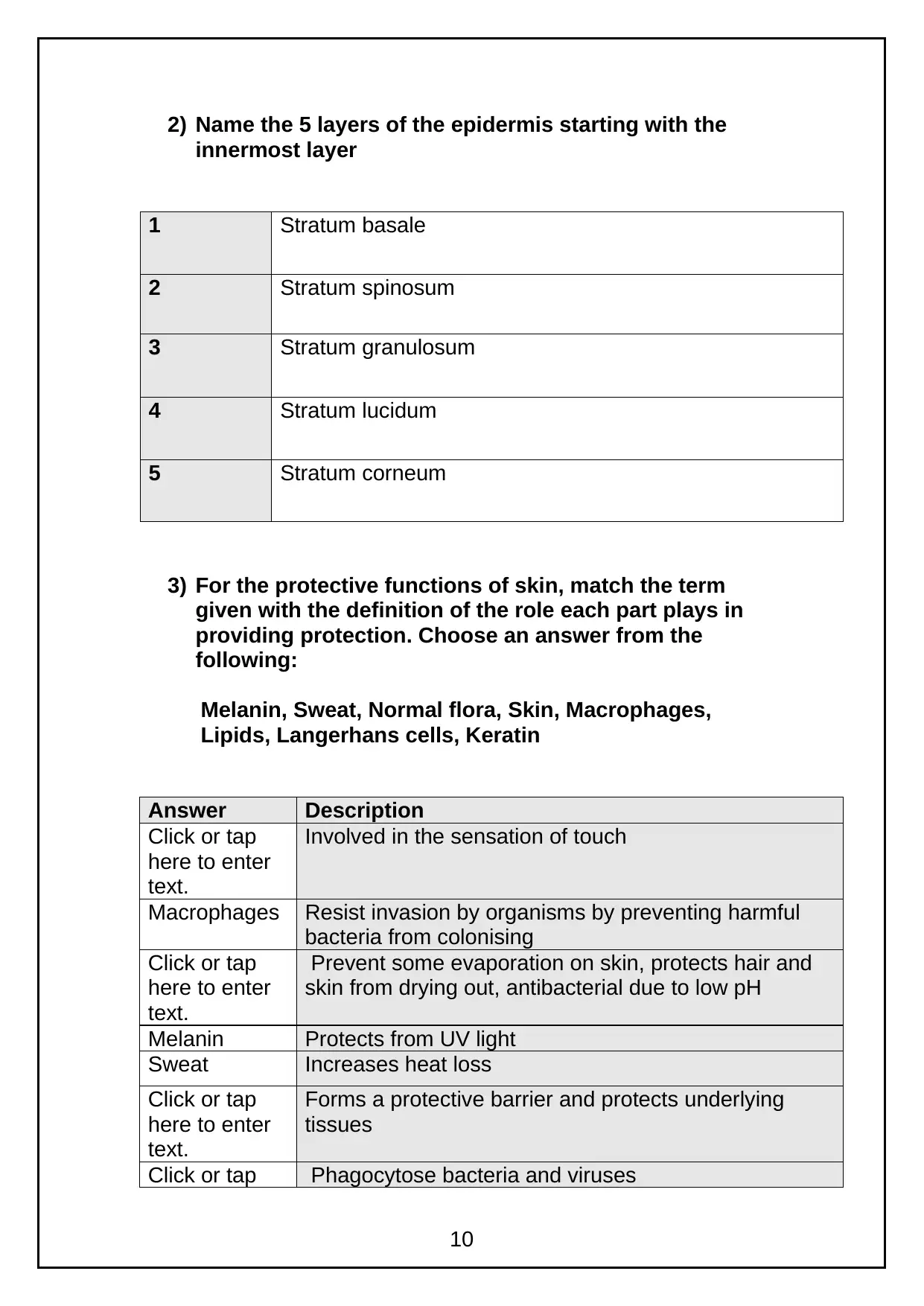
2) Name the 5 layers of the epidermis starting with the
innermost layer
1 Stratum basale
2 Stratum spinosum
3 Stratum granulosum
4 Stratum lucidum
5 Stratum corneum
3) For the protective functions of skin, match the term
given with the definition of the role each part plays in
providing protection. Choose an answer from the
following:
Melanin, Sweat, Normal flora, Skin, Macrophages,
Lipids, Langerhans cells, Keratin
Answer Description
Click or tap
here to enter
text.
Involved in the sensation of touch
Macrophages Resist invasion by organisms by preventing harmful
bacteria from colonising
Click or tap
here to enter
text.
Prevent some evaporation on skin, protects hair and
skin from drying out, antibacterial due to low pH
Melanin Protects from UV light
Sweat Increases heat loss
Click or tap
here to enter
text.
Forms a protective barrier and protects underlying
tissues
Click or tap Phagocytose bacteria and viruses
10
innermost layer
1 Stratum basale
2 Stratum spinosum
3 Stratum granulosum
4 Stratum lucidum
5 Stratum corneum
3) For the protective functions of skin, match the term
given with the definition of the role each part plays in
providing protection. Choose an answer from the
following:
Melanin, Sweat, Normal flora, Skin, Macrophages,
Lipids, Langerhans cells, Keratin
Answer Description
Click or tap
here to enter
text.
Involved in the sensation of touch
Macrophages Resist invasion by organisms by preventing harmful
bacteria from colonising
Click or tap
here to enter
text.
Prevent some evaporation on skin, protects hair and
skin from drying out, antibacterial due to low pH
Melanin Protects from UV light
Sweat Increases heat loss
Click or tap
here to enter
text.
Forms a protective barrier and protects underlying
tissues
Click or tap Phagocytose bacteria and viruses
10
Paraphrase This Document
Need a fresh take? Get an instant paraphrase of this document with our AI Paraphraser
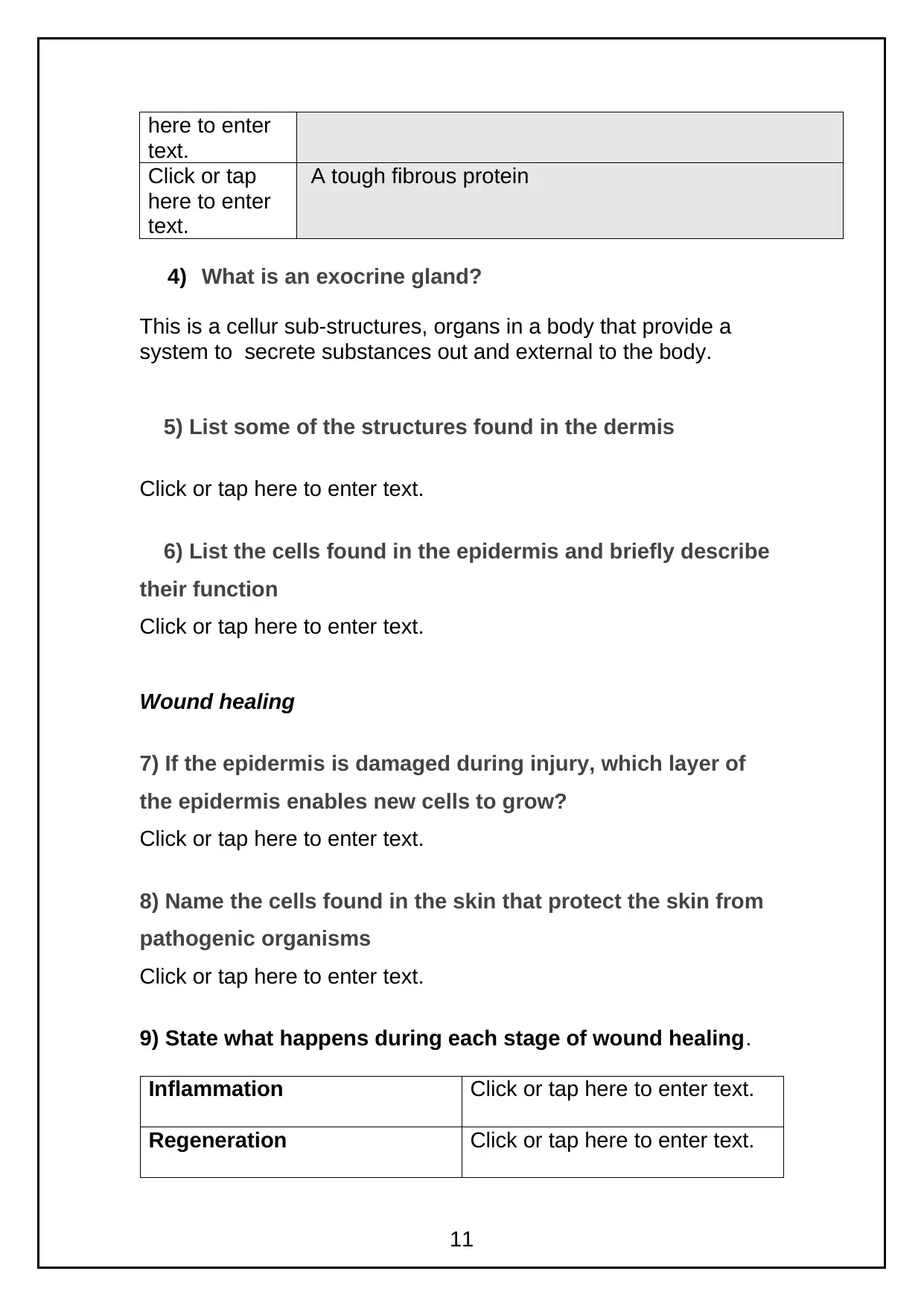
here to enter
text.
Click or tap
here to enter
text.
A tough fibrous protein
4) What is an exocrine gland?
This is a cellur sub-structures, organs in a body that provide a
system to secrete substances out and external to the body.
5) List some of the structures found in the dermis
Click or tap here to enter text.
6) List the cells found in the epidermis and briefly describe
their function
Click or tap here to enter text.
Wound healing
7) If the epidermis is damaged during injury, which layer of
the epidermis enables new cells to grow?
Click or tap here to enter text.
8) Name the cells found in the skin that protect the skin from
pathogenic organisms
Click or tap here to enter text.
9) State what happens during each stage of wound healing.
Inflammation Click or tap here to enter text.
Regeneration Click or tap here to enter text.
11
text.
Click or tap
here to enter
text.
A tough fibrous protein
4) What is an exocrine gland?
This is a cellur sub-structures, organs in a body that provide a
system to secrete substances out and external to the body.
5) List some of the structures found in the dermis
Click or tap here to enter text.
6) List the cells found in the epidermis and briefly describe
their function
Click or tap here to enter text.
Wound healing
7) If the epidermis is damaged during injury, which layer of
the epidermis enables new cells to grow?
Click or tap here to enter text.
8) Name the cells found in the skin that protect the skin from
pathogenic organisms
Click or tap here to enter text.
9) State what happens during each stage of wound healing.
Inflammation Click or tap here to enter text.
Regeneration Click or tap here to enter text.
11
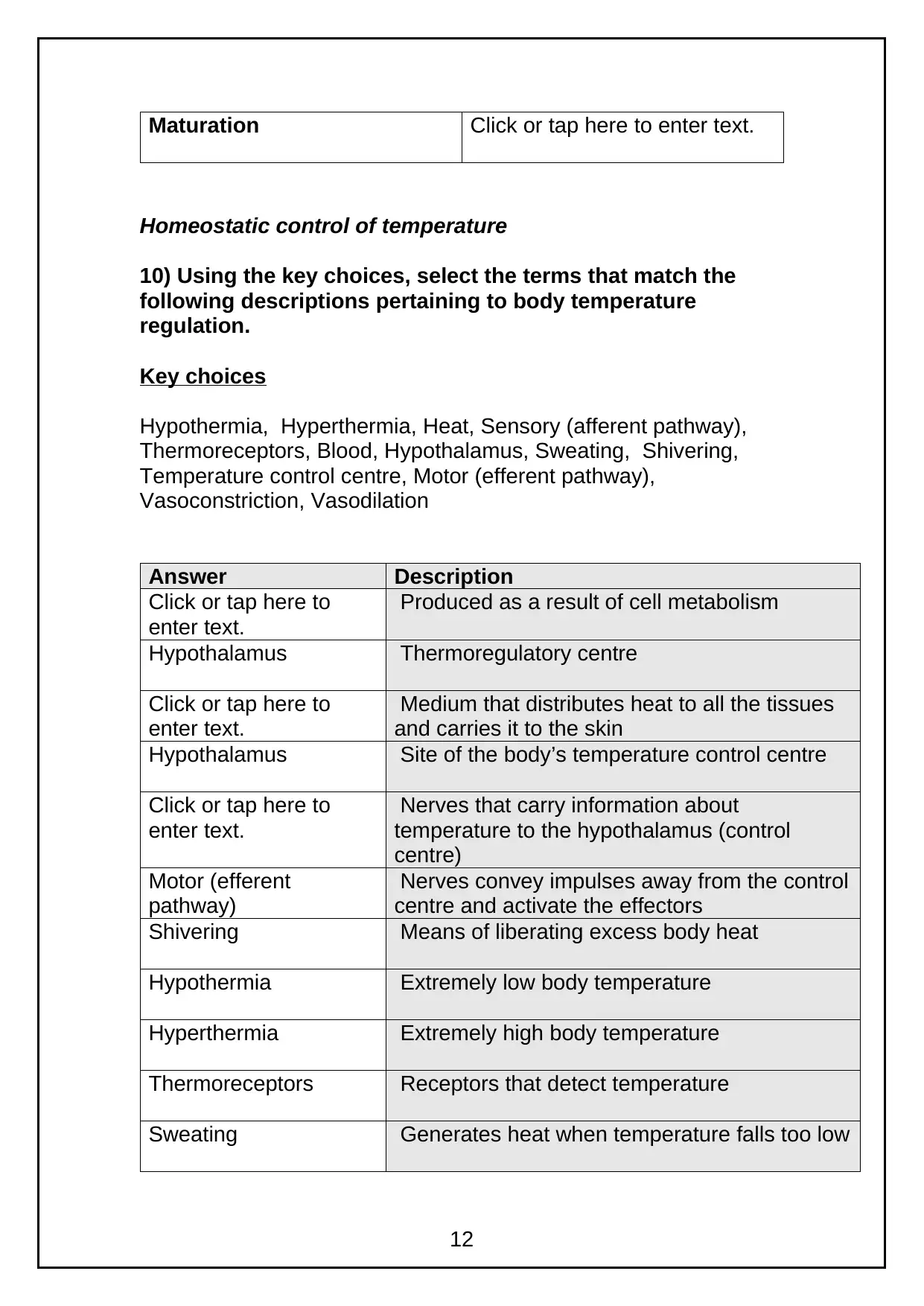
Maturation Click or tap here to enter text.
Homeostatic control of temperature
10) Using the key choices, select the terms that match the
following descriptions pertaining to body temperature
regulation.
Key choices
Hypothermia, Hyperthermia, Heat, Sensory (afferent pathway),
Thermoreceptors, Blood, Hypothalamus, Sweating, Shivering,
Temperature control centre, Motor (efferent pathway),
Vasoconstriction, Vasodilation
Answer Description
Click or tap here to
enter text.
Produced as a result of cell metabolism
Hypothalamus Thermoregulatory centre
Click or tap here to
enter text.
Medium that distributes heat to all the tissues
and carries it to the skin
Hypothalamus Site of the body’s temperature control centre
Click or tap here to
enter text.
Nerves that carry information about
temperature to the hypothalamus (control
centre)
Motor (efferent
pathway)
Nerves convey impulses away from the control
centre and activate the effectors
Shivering Means of liberating excess body heat
Hypothermia Extremely low body temperature
Hyperthermia Extremely high body temperature
Thermoreceptors Receptors that detect temperature
Sweating Generates heat when temperature falls too low
12
Homeostatic control of temperature
10) Using the key choices, select the terms that match the
following descriptions pertaining to body temperature
regulation.
Key choices
Hypothermia, Hyperthermia, Heat, Sensory (afferent pathway),
Thermoreceptors, Blood, Hypothalamus, Sweating, Shivering,
Temperature control centre, Motor (efferent pathway),
Vasoconstriction, Vasodilation
Answer Description
Click or tap here to
enter text.
Produced as a result of cell metabolism
Hypothalamus Thermoregulatory centre
Click or tap here to
enter text.
Medium that distributes heat to all the tissues
and carries it to the skin
Hypothalamus Site of the body’s temperature control centre
Click or tap here to
enter text.
Nerves that carry information about
temperature to the hypothalamus (control
centre)
Motor (efferent
pathway)
Nerves convey impulses away from the control
centre and activate the effectors
Shivering Means of liberating excess body heat
Hypothermia Extremely low body temperature
Hyperthermia Extremely high body temperature
Thermoreceptors Receptors that detect temperature
Sweating Generates heat when temperature falls too low
12
⊘ This is a preview!⊘
Do you want full access?
Subscribe today to unlock all pages.

Trusted by 1+ million students worldwide
1 out of 46
Your All-in-One AI-Powered Toolkit for Academic Success.
+13062052269
info@desklib.com
Available 24*7 on WhatsApp / Email
![[object Object]](/_next/static/media/star-bottom.7253800d.svg)
Unlock your academic potential
Copyright © 2020–2025 A2Z Services. All Rights Reserved. Developed and managed by ZUCOL.

